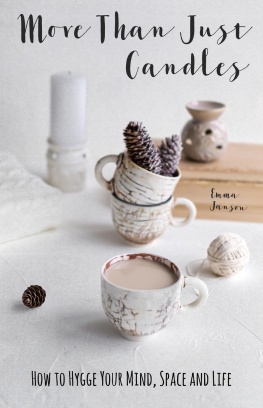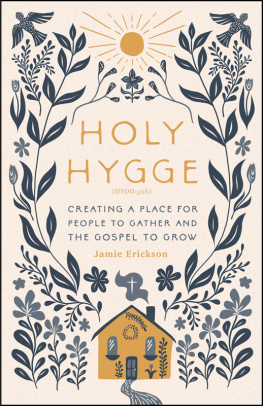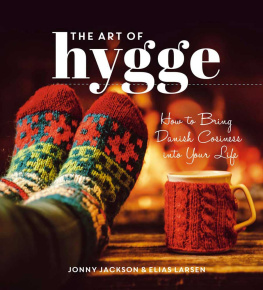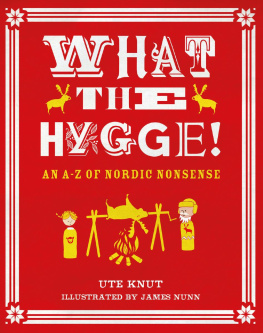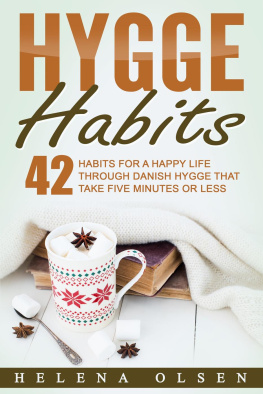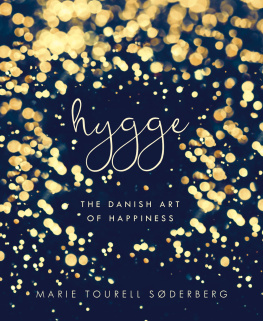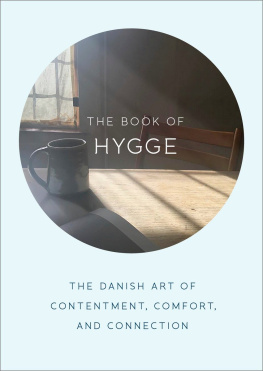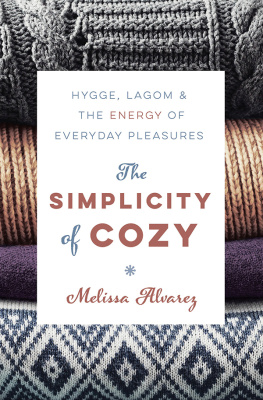More Than Just Candles:
How to Hygge
Your Mind, Space
and Life
EMMA JANSON
Copyright 2017 Emma Janson
All rights reserved.
CONTENTS
Introduction
What is Hygge?
Bridging the cultural gap
Hygge may call to you for lots of reasons
Get started
The Commercialization of hygge
Not just a lifestyle trend
Hygge your mind
Mindfulness
Consciously Slow down
Practice being positive
Practice being grateful
Meditation
Hygge your space
Your town
Home
Office
Shopping
Fire
Food
Update your lounge wear
Making not so hygge moments hygge
Outside
Hygge by the Ocean:
Rainy Days
Off-season
Hygge in all seasons
Winter
The Christmas season
Spring: new beginnings, hope, wonder
Summer: warmth in the air, lush greenery, relaxed atmosphere
Fall: hot cider, pumpkins, plaid and your favorite socks
Hygge your life (time)
Make time for hobbies
Remember to create
Hygge in the big moments
Hygge for the traveler
Sharing hygge with your loved ones
Family & friends: build a sense of community
Choosing relationships carefully
Improve the quality of your interactions with family and friends
Be forgiving
No controversy in hygge moments
Hygge on your own
Coziness in different times of the day
Love the simple things
Manage your tech - embrace the benefits of unplugging
All the other tech
A smack upside the head for workaholics, perfectionists and self-proclaimed type As.
Taking care of yourself: exercising and eating well
Related concepts: lagom and minimalism
Conclusion
Introduction
S everal months ago , I visited a dear friend of mine. It was a dark and cold Saturday night in the dead of winter, and he invited a few friends, including myself, over for dinner. When I arrived, he greeted me at the door with a big hug and a smile. He was wearing an incredibly soft cream coloured cashmere sweater, thick wool socks, and a pair of his favorite jeans. He walked me into the kitchen where a beautiful spread of cured meats, cheeses and different kinds of olives, fruits and nuts were laid out on gorgeous ornate, vintage serving trays. There were wine glasses set out for each of his guests, and all of his dishes, food and flatware were carefully selected to look beautiful together. Tea candles dotted the shelves and windowsills. He served us a lovely meal with pasta, salad, roasted meats and Italian wine he had chosen specifically for our food. We had a long drawn out meal and chatted about our families, our work, our lives. We shared jokes, laughed and just enjoyed each others company.
We didnt know it, but we were having a magical hygge evening.
What is Hygge?
Hygge, pronounced (hoo-gah), has been described as being consciously cozy, or an act of creating a safe and comforting environment. There is no direct English translation for hygge, but definitions which come close point to terms like cozy or coziness, charm, content, and warmth. The most important thing to understand is that it refers to a feeling - the feeling of being content, and experiencing coziness and warmth. To expand on that definition a little, the word also expands to describing the recognition of value in a simple moment. At its core is an emphasis on the simple things, slowing down, and this ones important gratitude.
For the purposes of this book, well call making the conscious choice to cultivate this experience in your life practising hygge.
Hygge originated in Norway, but was later adopted into the Danish cultural tradition were more familiar with today. Hygge emerged as a concept to combat the cold, brutal winters in Scandinavia. During certain times of the year in Denmark, its dark for 17 hours per day. Hygge was the answer to the resulting depression that crept in. Its a wonderfully inspiring concept if you think about it. It shows humans capacity for adaptability and resilience. We can take the cold, dark, depressing Danish winter and create a concept that has helped develop one of the happiest nations in the world.
A quick google search of hygge will lead you to a lot of advice about decorating and links to places where you can buy fuzzy socks and candles. This is because hygge is partly about setting a cozy and inviting atmosphere, and focusing on the aesthetic of space gets a lot of focus and attention. In this book, you will find information on setting up a hygge aesthetic and making use of a few cozy items, however, youll also find a lot more. This admittedly North American interpretation of the research on this subject and attempts at incorporating it into my life have led to my understanding of hygge as a state of mind. For this reason, this book shares some insight into how to shift your perspective away from some anti-hygge habits we westerners have ingrained in our modern culture to help you slow down to the pace of hygge.
This book is centered on how to incorporate hygge into your life. As the concept has been embraced outside of the Nordic countries, it has evolved in how it is practiced. Even within Denmark, the term is loosely applied to a variety of situations. Different people have different interpretations of how to practice hygge, and this book offers a broad perspective on how to incorporate it into your life that focuses on mindfulness, and setting up your frame of mind to embrace hygge the way it was meant to be embraced. While the more traditional take on hygge will be noted as we go, the focus in this book is more on how to bring your mind to your hygge practice in any situation, any season, and any time of day.
Bridging the cultural gap
After hearing a bit about hygge, you may notice it sounds a bit familiar. Just because the country you live in hasnt given this concept a proper name, doesnt mean the people around you dont still enjoy it. Its good to name it though, because naming it gives it power and definition. To help you wrap your mind around the concept a bit more, if youre an English speaker, it may help to think of it a bit like nostalgia for today.
Since there is no direct translation, and no identical North American cultural norm to compare it to, I think another way of looking at hygge as being nostalgic for the present. What exactly do I mean by this? Well, consider how we are when we are nostalgic about the past. Think about a time you remember fondly. Are there movies or songs that remind you of those moments? What about smells? Or food, like a particular ice cream store or the roast your grandma used to make? Are there places you go to try and relive old memories and feelings? Relationships you hold onto because of how good they used to be?
Its valuable to have happy and warm memories. If you think about it though, it can make us a little sad, cant it? I had a camp ground I used to go to with my family as a child, and after we stopped going I went back a couple of times as an adult to try and relive those memories. While it was a little comforting to see it again, I actually found it sadder to visit later on. Things had changed, and there was no happiness or warmth in the air. To use an old clich, it just didnt feel the same.
Looking back on the first few years after we stopped going as a family, and remembering visiting old friends, I actually found more comfort in letting go. Moving on and finding new places to make new memories felt better than trying to hold onto the past, even if it was difficult at first.
After laughing with old friends about old times, I find theres really no escaping the twinge of sadness that lingers at the end. Nostalgia for the past, by nature, is haunted. That being said, walking into a shop themed from a previous point in time in your life, or watching an old show from when you were a teenager does give us this feeling of warmth and comfort because its safe and familiar. With hygge we can feel that same sense of content without sadness creeping in. With a bit of a mind shift, we can feel the same warmth and comfort about our present moments. You probably already do this in some ways without even realizing it. When you prepare your favorite food or go take a walk in a park you really like, youre finding ways to enjoy life right now.
Next page
